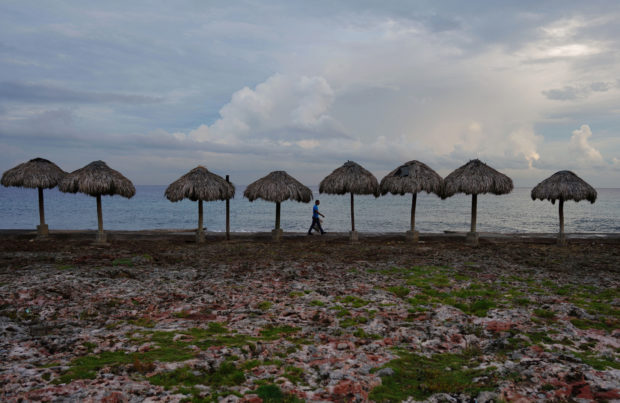Hurricane Ian begins to lash Cuba with heavy winds, rain

A man collects empty cans at the seafront ahead of the arrival of Tropical Storm Ian in Havana, Cuba, September 26, 2022. REUTERS
BATABANO, Cuba — The first strong winds ahead of Hurricane Ian began to pound Cuba’s south coast late on Monday as officials rushed to evacuate residents, secure boats and batten down homes amid warnings of a life threatening storm surge.
The fast-growing storm is centered about 155 miles (250 km) southeast of Cabo San Antonio, in far western Cuba, but has jumped in intensity in recent hours with maximum sustained winds of 100 miles per hour (155 km per hour), making it a Category 2 hurricane on a five-step scale.
“Devastating wind damage is possible where the core of Ian moves across western Cuba,” the center said.
The storm is forecast to strengthen into a Category 3 or greater hurricane and barrel north to the Florida coast, where residents are stockpiling supplies and filling sandbags.
Residents of Batabano on Cuba’s south coast worked with many fewer resources than in Florida as the storm closed in, threatening the fishing village of precarious wooden and concrete block houses perched just a few paces from the roiling sea.
Article continues after this advertisement“We are here saving human lives, going house to house, taking out the elderly and children,” said local official Suleika Roche, 43, aboard a bus that was transporting residents to high ground.
Article continues after this advertisementThe storm is set to plow north across the island as it advances into the Gulf of Mexico, but forecasts put its track well west of the Cuban capital of Havana, where a direct hit could cause catastrophic damage to the city´s antiquated infrastructure.
Cuba is already suffering an economic crisis that has led to long lines for food, fuel and medicine, as well as regular blackouts countrywide. Most grocery store shelves have been largely bare for months, complicating preparations for the storm.
“I´m buying bread now because later I won´t be able to leave my house,” said Havana resident Guillermo Gomez, 79, as he waited in a line that stretched several blocks for a few pieces of bread. “The water will be up to my knees.”
On the capital´s waterfront Malecon boulevard, some residents boarded up windows. Others, lacking boards, taped them to keep them from shattering, while others simply removed the glass altogether.
Juan Ruiz, a custodian for a coffee shop looking over the Straits of Florida, said the business had stripped all its merchandise and equipment the night before, preferring to work with the sea instead of fighting it.
“We´ve been preparing since Saturday,” Ruiz said as the wind began to raise whitecaps on the water. “The sea always surges here.”
Cuba´s government called off interprovincial train and bus travel across the western half of the island ahead of the storm. Officials said they were also monitoring aging dams, many of which were already nearing capacity before the storm.
Florida bound
The storm appears poised to cut a swath across the tobacco-growing province of Pinar del Rio, a more lightly populated area of the island dedicated primarily to farming and fishing.
Officials in Pinar del Rio said they would evacuate 24,000 people from the province ahead of the hurricane.
Fertilizer, charcoal and farm animals had been moved to secure locations, officials said, and infrastructure for the region´s tobacco industry protected.
Forecasters said that once Ian left western Cuba, the storm could make landfall north of Tampa Bay early on Friday or turn northwest toward Florida’s Panhandle.
The Biden administration declared a public health emergency for the state on Monday and said it was working with local officials to provide support.
Both Cuba and Florida have in recent years seen wetter, windier and more intense hurricanes, which some experts attribute to climate change.
There is also evidence that climate change is causing storms to travel more slowly, dumping more water in one place.
RELATED STORIES
Hurricane Ida hits Cuba’s Isle of Youth; U.S. Gulf Coast braces for hit
US Gulf Coast residents flee ‘extremely dangerous’ Hurricane Ida